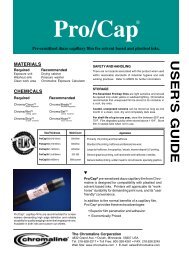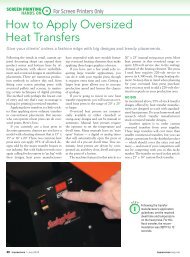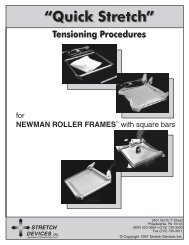Download Boosting Your Productivity With These Simple Shop ...
Download Boosting Your Productivity With These Simple Shop ...
Download Boosting Your Productivity With These Simple Shop ...
You also want an ePaper? Increase the reach of your titles
YUMPU automatically turns print PDFs into web optimized ePapers that Google loves.
By James Ortolani,<br />
Contributing Writer<br />
CSF NO. 5: UNDERSTANDING<br />
OFF-CONTACT PRINCIPLES<br />
Most garments are screen printed off-contact.<br />
This simply means that the actual<br />
screen supporting the design element is suspended<br />
about 1 ⁄16-inch above the garment’s<br />
surface during the print cycle. Downward<br />
pressure from the force of the squeegee<br />
makes the screen touch the garment directly<br />
under the squeegee blade. The screen<br />
then “snaps off” the garment surface right<br />
behind the moving squeegee blade.<br />
Increasing this off-contact distance<br />
(between the garment and the screen)<br />
increases the thickness of the ink deposit,<br />
while, of course, reducing off-contact distance<br />
reduces the amount of ink printed on<br />
the surface of the shirt. There is a real art to<br />
dialing in the perfect off-contact distance to<br />
get the most out of your printed design.<br />
Opacity is not an issue when printing on<br />
white garments, so use very little offcontact<br />
for a thin ink deposit. Printing black<br />
T-shirts requires more off-contact distance<br />
to lay down more ink for better coverage.<br />
Here’s a snapshot of how to attach<br />
mesh to a retensionable frame. The inset<br />
image at top left shows the end of the frame’s side bar.<br />
Below that, an employee is using the screen tension<br />
tool and in the inset photo at bottom right, he is attaching<br />
mesh to the frame.<br />
CSF NO. 6: WHITE ON<br />
DARK PRINTING<br />
Squeegee techniques and controlling<br />
downward squeegee pressure play a major<br />
role in achieving the brightest white print<br />
on dark garments. Excess squeegee pressure<br />
will drive the ink through the garment,<br />
exposing its surface and making the<br />
ink appear washed out. Backing off<br />
squeegee pressure allows ink to sit on the<br />
surface of the garment, which yields the<br />
best ink coverage and opacity. If you can<br />
see white ink on your shirt board after you<br />
remove the garment from the press, you<br />
are pressing too hard on the squeegee.<br />
CSF NO. 7: SQUEEGEE<br />
FUNDAMENTALS<br />
Squeegee speed is instrumental in controlling<br />
the amount of ink that is delivered to<br />
the shirt’s surface. A slow squeegee stroke<br />
allows more time for the ink to flood the<br />
image area, delivering a larger volume of<br />
ink to the garment. A fast squeegee reduces<br />
the amount of ink on the garment surface.<br />
Squeegee hardness also is a major consideration.<br />
A common squeegee hardness<br />
for everyday garment printing is in the 70-<br />
durometer range. A high durometer number<br />
indicates a harder squeegee material,<br />
which is preferred by printers doing fine<br />
halftones in four-color process work. A<br />
55/60 durometer squeegee is ideal for special<br />
effect inks such as puff or suede.<br />
Finally, keep your squeegees sharp and<br />
experiment with the squeegee angle when<br />
printing. Although a 45-degree angle is the<br />
starting point for the squeegee in relationship<br />
to the screen, you can get a higher volume<br />
of ink to pass through the open areas<br />
of the screen by laying the squeegee back<br />
to a 40-degree angle.<br />
CSF NO. 8: MONOFILAMENT<br />
POLYESTER MESH<br />
This is the main screen fabric being used in<br />
today’s commercial screen printing industry.<br />
Each individual strand is extruded<br />
polyester (plastic) held to very tight tolerances<br />
in terms of controlling the thread<br />
diameter. The thread diameter is measured<br />
in microns and has a dramatic effect on<br />
print quality as it determines the amount<br />
of open area at the mesh grid cross section.<br />
In simple terms, a thicker thread blocks<br />
more ink in the mesh cross section than a<br />
thinner thread of the exact same mesh<br />
count.<br />
Warp and weft also are terms you need<br />
to learn when working with screen mesh.<br />
The warp is the length direction of the<br />
screen fabric as it comes off the bolt (roll<br />
of mesh) and the weft is the left-to-right<br />
weave between the selvedges (edge to<br />
edge). Historically, threads in the warp<br />
direction could be taken to a higher tension<br />
level due to the weave configuration<br />
and the fact that the long length of warp<br />
thread allowed for better elongation. But<br />
with today’s low-elongation mesh and<br />
improved weaving technology, the warp<br />
and weft threads have become more<br />
equal.<br />
CSF NO. 9: RETENSIONABLE<br />
FRAMES<br />
<strong>These</strong> are popular because they make it<br />
easier to control and increase screen tension.<br />
There are basically two types of retensionable<br />
frames available — roller type and<br />
square. Both systems deliver what you<br />
want, which is higher tensioned mesh.<br />
Whichever system you go with, the<br />
frame in question must be easy to retension.<br />
I see too many shop owners who<br />
don’t retension their (expensive) frames on<br />
a consistent basis. Employee turnover<br />
might be part of the problem, which is<br />
another good reason why retensionable<br />
frames should be easy for the novice to<br />
stretch and use.<br />
Once screens have been retensioned<br />
several times, they become work-hardened<br />
and are ideal to hold tight registration. In<br />
scientific terms, the phenomena of “cold<br />
flow” occurs when molecules in the polyester<br />
thread are stretched. Screen mesh<br />
that is work-hardened is very stable, making<br />
it possible to hold registration on long<br />
runs with little to no tension loss.<br />
CSF NO. 10: COOL-DOWN<br />
STATIONS<br />
When flashing plastisol inks, cooling stations<br />
provide better ink opacity. Whether<br />
you use a manual or automatic press, it is<br />
important to have multiple load stations so<br />
an open position can serve as a cool-down<br />
station. If you don’t allow for cooling<br />
directly after a print has been flashed, the<br />
inks will be tacky and stick to the next<br />
screen they come in contact with. This<br />
characteristic is referred to as “after-flash<br />
tack” and results in unnecessary downtime.<br />
Following the Critical Success Factors<br />
outlined above will allow you to make the<br />
gradual transition into becoming a topnotch<br />
screen print shop.<br />
James Ortolani has more than 25 years experience,<br />
specializing in screen printing and heat<br />
transfers. He has worked for a variety of industry<br />
suppliers, including Hix Corp., where he<br />
currently serves as national sales manager.<br />
Contact him at jortolani@hixcorp.com.<br />
impressionsmag.com October 2007





